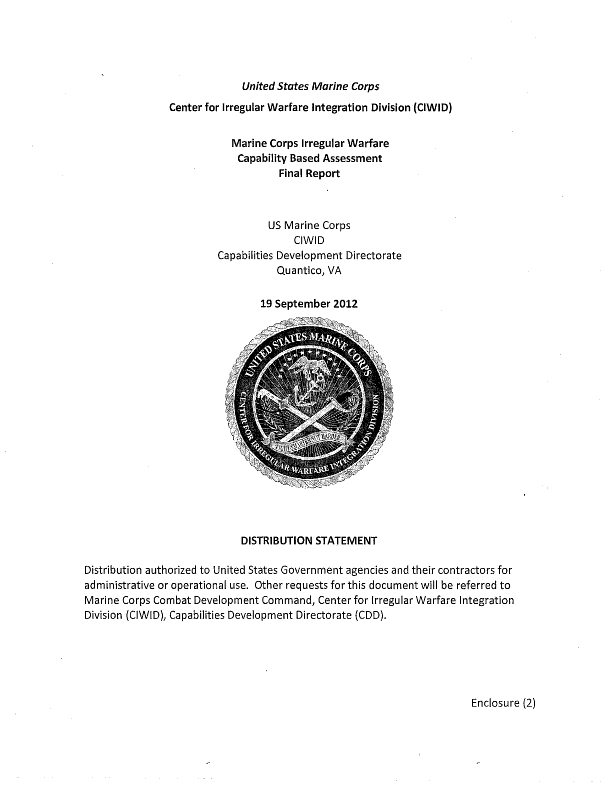Center for Irregular Warfare Integration Division (CIWID)
- 21 pages
- Distribution authorized to United States Government agencies and their contractors for administrative or operational use.
- September 19, 2012
Center for Irregular Warfare Integration Division (CIWID) was directed to conduct a Capabilities Based Assessment (CBA) on Irregular Warfare (IW) to ensure that the Marine Corps is properly postured to conduct IW operations and activities in the future. This document provides the results of the analysis and the recommended way ahead. The IW CBA message directed CIWID to “provide insights/observations after each phase of the study which may be used in support of future force structure deliberations.”
• Despite 10 years of war, the Marine Corps has yet to fully institutionalize IW across Doctrine, Organization, Training, Materiel, Leadership and Education, Personnel and Facilities (DOTMLPF). The Marine Corps needs to preserve and document IW capabilities so that capacity may be regenerated, as required to meet future demand.
• IW activities are fully nested in all aspects of Forward Engagement, Crisis Response, Long Term IW and Major Combat Operations (MCO).
• The lack of a clear demand signal clouds the issue of the exact required IW capacity.The Marine Corps fully participated in the IW Joint Operational Concept (JOC) Capabilities Based Assessment Process. That process led to 128 Joint DOTMLPF Change Requests (DCRs) and the revision of the IW JOC into a version 2 by 17 May 2010. These concepts and recommended DCRs were used to fully inform the internal Marine Corps IW CBA process. Marine Corps progress on the Joint IW DCRs is tied to implementation of the Service IW CBA and is updated through the Joint IW CBA Campaign 0-6 Review Group.
The Marine Corps IW CBA identified 34 individual required capabilities. Of these, 13 were determined to have gaps in capability or capacity. CIWID mitigated one gap by related solutions. 75 solutions were recommended across DOTMLPF for the 12 solution sets.
Throughout the USMC IW CBA process, CIWID has kept the advocates (Ground Combat Element (GCE), Air Combat Element (ACE), Combat Element (CE) and Logistics Combat Element (LCE)) informed on the development of capabilities, gaps and solutions. The vast majority of IW solutions have fallen within the CE and the Command Element Advocacy Board (CEAB). Although IW capabilities did not achieve separate capabilities within Program Objective memorandum (POM) 15, they have been mapped and nested within existing gaps. Solution strategies from the IW CBA have been incorporated into the POM-15 Solutions Planning Directive (SPD).
The USMC IW CBA identified only one material solution, Civil Affairs Information Data Processing System (CIMDPS); known as Marine Civil Information Management System (MARCIMS) (MCPC: 460113). This program has been fully recognized and is currently competing in the Marine Corps Enterprise Integration Process (MCEIP). Recommended IW solutions that require additional resources will be consolidated into five separate proposed Marine Corps Requirements Oversight Council (MROC) Decision Memorandums (Advising, COIN, StabOps, IW Skills Tracking and IW Organizational solutions). The results of the MROC decisions will be incorporated into a Capability Investment Plan chapter ofthe MCEIP, and as well as integrated within the various phases ofthe Marine Corps Force Development System (MCFDS) process. With the Marine Corps IW CBA complete, CIWID is prepared to fully participate in POM 16 and reexamine the capabilities, gaps and solutions based on solutions or changes to guidance. CIWID will also consider conducting follow on CBAs to determine capability requirements for Security Force Assistance (SFA), Counterterrorism (CT) and Unconventional Warfare (UW).

